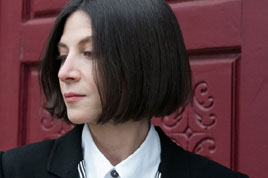Review of The Little Friend by Donna Tartt
Donna Tartt returns after 10 years, but has mystique survived? - Chicago Tribune - November 7, 2002By Nara Schoenberg.
NEW YORK
She blends in seamlessly in this Park Avenue neighborhood of glistening galleries and high-end shops: a delicate, almost doll-like figure, barely 5 feet tall, with a tailored blue suit and a silky black bob.
She heads to the back of a neighborhood teahouse and perches in the power seat, the one in the corner where no one can see you without in turn being seen. She fiddles with her purse, allowing a few seconds of awkward silence.
And then she looks up.
Her eyes, palest green in the shadows of the foyer, are pure gold now _ gold and unblinking _ cat eyes, vampire eyes, the strangest eyes you've ever seen.
Readers of Donna Tartt's first novel, "The Secret History," will be familiar with those yellow high-beams, which once peered out from photo after photo in the nation's largest newspapers and magazines. With her Southern Gothic past, her highbrow best seller, her glowing reviews, her rapturous Vanity Fair profile, Tartt, just 28 at the time, was the young writer to watch in 1992.
In her novel, she conjured up the ecstatic abandon of ancient Greek ritual, made readers believe in charm so potent it can blind, pride so fierce it _ literally _ can kill.
She amassed a cult following: young people who read her tale of cold-blooded murder at an elite East Coast college five, 10, 20 times.
And then, she simply disappeared.
Ten years later, the notoriously close-lipped Tartt is back with a second book, "The Little Friend," a rare publicity tour and a mystique that has only been enhanced by her long _ and virtually total _ retreat from public view.
In her absence, rumors swirled: Would Tartt, whose first novel was described by the Boston Globe as "by far the most interesting work yet from her generation," follow in the footsteps of one-hit wonders such as "To Kill a Mockingbird" author Harper Lee?
Would she ever write another book?
At Internet sites such as the "Donna Tartt Shrine," fans pondered worst-case scenarios, pronounced the first book their "bible," extolled the author's "frail beauty" and begged her to write more.
But if friends and foes alike were besieged by doubt, Tartt, now 38, would have you believe that the fate of her second novel _ the tale of a 12-year-old girl haunted by her brother's murder _ was never seriously in doubt.
"I always knew it was there, you know?" she says of the book she began before she had even finished "Secret History."
"Yeah," she says, her tiny hands twisting in the air, as if to indicate the presence of the unseen. "I knew it was there."
Tartt's first book, begun when she was a student at Bennington College in Vermont, was an overnight sensation eight years in the making. It had celebrity support _ novelist Bret Easton Ellis, a college classmate, was an early reader and a fan. The book had the services of literary superagent Amanda "Binky" Urban.
And then there was the story itself: a tale that began with a rich boy named Bunny lying dead in the snow and circled back to a glamorous clique of college students whose single-minded devotion to the ideals of the ancient Greeks had paved the way to murder.
"Bloody, terrible things are sometimes the most beautiful," says the students' hero, a charismatic professor who overseas virtually all aspects of their education.
The new novel, set in sleepy small-town Mississippi, could not be more different from the first: languid where its predecessor was breathlessly paced, resolutely inward-looking where the first book was obsessed with appearances. The picturesque college kids and self-styled aristocrats of the first novel have disappeared without a trace, replaced by a cast of awkward children, scruffy rural drug addicts and penny-pinching great-aunts.
Early reviews mostly ranged from positive to glowing, with Newsweek calling the novel "extraordinary." The New York Times, however, recently gave the book an ominous thumbs-down, and Entertainment Weekly declared it "incoherent melodrama" and "an extended prose catastrophe."
In "The Little Friend," 12-year-old Harriet Cleve Dusfresnes sets out to solve the murder of her elder brother, Robin, the family's golden boy, found hanging from a tree in their yard when he was only 9. Fierce, dogmatic and bent on revenge, Harriet is part child, part military general.
Her quest, played out against a backdrop of dank woods and moonlit lawns rapidly spins out of control, threatening to unleash yet another explosion of deadly violence.
If the first book was supremely effortless, "The Little Friend" is, on some level, a celebration of effort, full of images of struggle, such as a decaying family mansion called Tribulation and a child with a familiar pale, unblinking, "bobcat" stare fighting, second by agonizing second, to hold her breath under water.
"I wanted to try something different," Tartt says, "but also different in that it was more difficult. I was ready to take on a more ambitious technique. I wanted to try to expand my range."
If "The Secret History" was a concerto for a single instrument, she says, "The Little Friend" was a symphony for the entire orchestra: "So it was the difficulty of switching from writing one thing, one voice _ `The Secret History' was all one voice, one set of eyes _ to a more sounded, richer, more varied work."
Also difficult, she says, was writing sections of the book from the point of view of a child.
"Children, they're so at the mercy of adults, they have to watch everything," she says. "They're like dogs (that) have to watch their owner all the time, to see, you know, `Are we going out? Is he going to the refrigerator?'"
"Children are like that. They don't have any control at all, so they have to be very watchful of the adults around them. But at the same time, they don't have enough experience to really draw accurate conclusions from what they see, and, more than anything, they don't understand how much their own emotions color things."
Tartt's own small-town Mississippi childhood was, by her own account, colorful. In a 1992 essay in Harper's magazine, she recalled a great-grandfather whose adoration for her was matched only by his fears for her health.
"He mourned for me as if I were already dead" when she began having problems with her tonsils at age 5, she wrote. He responded to her symptoms _ two years of fairly constant fever and illness _ by giving her whiskey at bedtime and dosing her regularly with codeine cough syrup, despite the lack of any detectable cough.
"Perhaps he was unaware the syrup had codeine in it; perhaps he was simply trying to make me comfortable in what he thought were my last days," Tartt wrote.
"But, for whatever reason, the big red bottles kept coming from the drugstore, and _ between the fever and the whiskey and the codeine _ I spent two years of my childhood submerged in a pretty powerfully altered state of consciousness."
Her father, a local politician, she recalled as a "black-haired, bad-tempered stranger."
Her mother, somewhat childish, but apparently a kindred spirit, understood Tartt's "gift" for plunging herself into "eerie, self-induced fits," having possessed the same ability in childhood. Tartt would stare at an object and repeat a word or phrase until it no longer made sense, until she was incapable of recognizing members of her own family.
For as much as four minutes, she would be unresponsive, "insensible" to the hands that shook her, the snapping of fingers, even the sound of her own name.
And then she would return, waking up to see the world as if for the first time, "like a person blind from birth who has just had the bandages unwrapped after an operation restoring sight."
Tartt is far less generous with her present that she is with information about her past. She'll say she is unmarried, but not whether she is dating. She'll say she's working on a new novel, but not what it is about.
She doesn't even like to have her picture taken, she says, an odd statement coming from an author whose mystique is based partly on striking photographic images: the cool, classical features, the large, wide-set eyes, the dark suits and inky hair.
The camera loves Tartt, but she doesn't love it back _ never has, she says. And, in a way, that makes sense. The camera flatters Tartt, but it also subdues her: dims her eyes, dulls her skin, smoothes the quirky contours of her face.
She is more perfect in photos, a statue carved in stone, but she is more interesting in person: a cat, a vampire and then, quite suddenly, a prophet at the moment of vision, head tilted back, eyes raised to meet a stream of gold light.
Chicago Tribune - November 7, 2002
©2002, Chicago Tribune.
+ + + Comments + + +



